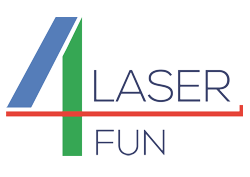Results of the work in the Laser4Fun project has been published as:
F. Fraggelakis, G. Mincuzzi, J. Lopez, I. Manek-Hönninger and R. Kling, “Controlling laser-induced features morphology on stainless steel surfaces using high average power femtosecond laser,” 2017 Conference on Lasers and Electro-Optics Europe & European Quantum Electronics Conference (CLEO/Europe-EQEC), Munich, 2017, pp. 1-1.
Abstract
Ultra-short pulse (USP) Laser Induced Periodic Surface Structures (LIPSS) namely ripples, micro-grooves and spikes [1] have received considerable attention since they can modify some key surface properties like wettability, colour and tribology, increasing the material’s internal value [2]. Nevertheless, the complete understanding of the physical mechanisms leading to LIPSS formation is still under debate. Even so, at repetition rate values as high as several kHz, the fluence Φ and the overall energy irradiated over a unit surface (dose) have been identified as the physical parameters playing a major role in the structures generation process [3][4][5].
However, for a fixed Φ value, in correspondence of repetition rate as high as few MHz, the same dose value could enable the creation of surface structures having different morphologies depending on the process strategy. In fact, the latter, i.e. the combination of pulses overlap and number of scans corresponding to a given dose value has a huge bearing to determine the heat accumulated during the process which in turn will determine the final structure morphology.[6]
Here, for the first time, we report a systematic study on the influence of a comprehensive set of process parameters like Φ, pulses overlap, number of scans and cumulative dose on the induced structure over stainless steel surface for two different wavelengths and high repetition rate. An industrial USP laser (τp< 350 fs) of high power (up to 20 W) operating at a repetition rate up to 1 MHz, emitting in the near infrared at λ = 1030 nm and at λ=515 nm by second harmonic generation was used to carry out the experiment. By comparing the results for two different repetition rates (100 kHz and 1 MHz), we aim to push more in deep the understanding of the physical mechanism that leads to spike creation by verifying the role of the inter-pulse delay in heat accumulation.
For both wavelengths, we demonstrate the transition from ripples to conical formation underlining the presence of groove formation as an intermediate step. Interestingly, for the first time, we demonstrate the possibility to finely tune the feature size in the case of 1 MHz. In fact, by varying the fluence between 0.22 J/cm2 and 0.65 J/cm2 feature sizes comprised between 8.3 μm ± 3 μm and 36 μm ± 10 μm.
Finally, by comparing the results obtained with several Φ values we propose an effective strategy not only to overcome the heat accumulation issue in the formation of the structures, but also for scaling up the process.
References
[1] H. M. Van Driel, J. E. Sipe, and J. F. Young, “Laser-induced periodic surface structure on solids: A universal phenomenon,” Phys. Rev. Lett., vol. 49, no. 26, pp. 1955–1958, 1982.
[2] A. Y. Vorobyev and C. L. Guo, “Optical and Wetting Properties of Femtosecond Laser Nanostructured Materials,” J. Nano Res., vol. 14, pp. 57–67, 2011.
[3] G. Mincuzzi, L. Gemini, M. Faucon, and R. Kling, “Extending ultra-short pulse laser texturing over large area,” Appl. Surf. Sci., vol. 386, pp. 65–71, 2016.
[4] M. Faucon, A. Laffitte, J. Lopez, and R. Kling, “Surface blackening by laser texturing with high repetition rate femtosecond laser up to 1MHz,” Proc. SPIE, vol. 8972, no. February, p. 89721M, 2014.
[5] O. Varlamova, M. Bounhalli, and J. Reif, “Influence of irradiation dose on laser-induced surface nanostructures on silicon,” Appl. Surf. Sci., vol. 278, pp. 62–66, 2013.
[6] D.-H. Kam, J. Kim, L. Song, and J. Mazumder, “Formation mechanism of micro-spikes on AISI 4340 steel with femtosecond laser pulses at near-threshold fluence,” J. Micromechanics Microengineering, vol. 25, no. 4, p. 045007, 2015.
